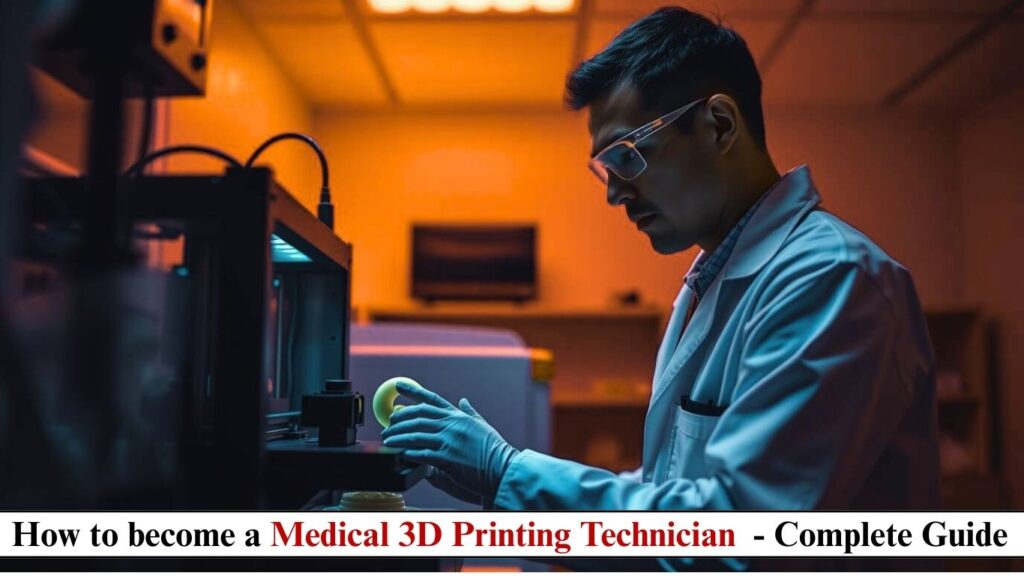
Introduction
Medical 3D printing is transforming modern healthcare, enabling patient-specific implants, surgical models, and even bioprinted organs. At the heart of this revolution are Medical 3D Printing Technicians – skilled professionals who combine engineering, anatomy, and digital fabrication to create life-changing medical solutions.
This guide covers everything you need to know about this cutting-edge career:
- The evolution of medical 3D printing
- Salary ranges across industries
- Day-to-day responsibilities
- Essential technical skills
- Step-by-step career path
- Future industry trends
Whether you’re an engineer, healthcare professional, or tech enthusiast, this guide will help you break into this high-growth field.
History of Medical 3D Printing
Early Innovations (1980s–2000s)
- 1984: Chuck Hull invents stereolithography (SLA), the first 3D printing technology
- 1999: First 3D-printed bladder successfully implanted (Wake Forest Institute)
- 2005: Dental labs adopt 3D-printed crowns and bridges
Clinical Adoption (2010–2015)
- 2012: FDA approves first 3D-printed skull implant
- 2013: Bioprinted liver tissue demonstrates drug metabolism
- 2015: First 3D-printed drug (Spritam) approved for epilepsy
Modern Breakthroughs (2016–Present)
- 2019: Surgeons implant first 3D-printed heart with human tissue
- 2022: AI-optimized bone scaffolds reduce healing time by 40%
- 2024: Hospitals establish in-house 3D printing labs for same-day prosthetics
Medical 3D Printing Technician Salary (2024)
| Experience Level | Average Salary (US) | Key Employers |
|---|---|---|
| Entry-Level (0–2 yrs) | $55,000–$75,000 | Dental Labs, University Hospitals |
| Mid-Career (3–7 yrs) | $75,000–$110,000 | Medical Device Companies, Research Centers |
| Senior (8+ yrs) | $110,000–$160,000 | Bioprinting Startups, FDA-Regulated Facilities |
Industry Variations:
- Highest Paying: Orthopedic implants ($130K+), Bioprinting R&D
- Fastest Growing: Dental applications (23% annual growth)
Location Premiums:
- Minneapolis (MedTech hub) +18%
- Boston (Academic medical centers) +22%
- Remote roles rare due to lab requirements
Roles & Responsibilities
1. Pre-Production Planning
- Convert CT/MRI scans into printable 3D models (DICOM to STL)
- Collaborate with surgeons on patient-specific implant designs
- Optimize structures for surgical usability and biocompatibility
2. Equipment Operation
- Operate industrial 3D printers:
- FDM for surgical guides
- SLS for durable implants
- SLA for dental models
- Bioprinters for tissue engineering
- Maintain ISO Class 8 cleanrooms for medical-grade production
3. Post-Processing
- Sterilize implants using autoclaves, gamma radiation
- Finish surfaces to sub-micron precision for joint replacements
- Conduct mechanical testing (compression, fatigue analysis)
4. Regulatory Compliance
- Document processes for FDA 510(k) submissions
- Implement Good Manufacturing Practices (GMP)
- Track material traceability (Ti6Al4V alloy batches)
5. Research & Development
- Test new bioinks for cartilage regeneration
- Develop AI-generated lattice structures for bone ingrowth
- Publish case studies in 3D Printing in Medicine journal
Required Qualifications
Education
| Degree | Best For | Top Programs |
|---|---|---|
| Biomedical Engineering | Implant Design | Johns Hopkins, Georgia Tech |
| Mechanical Engineering | Equipment Specialization | MIT, Stanford |
| Dental Technology | Prosthodontics | USC, NYU College of Dentistry |
| Biotechnology | Bioprinting | Harvard Wyss Institute |
Technical Skills
- CAD Software: Materialise Mimics, 3D Slicer, SolidWorks Medical
- Printer Expertise: Stratasys Dental Series, CELLINK Bioprinters
- Medical Imaging: OsiriX DICOM processing, segmentation
- Materials Science: Know FDA-approved powders/resins (PEEK, HA/TCP)
Certifications
- AMT Certified Additive Manufacturing Technician
- ASME Medical 3D Printing Certificate
- ISO 13485 (Medical Devices) Training
- Bioprinting Specialization (CELLINK Academy)
How to Get Started: 5-Step Roadmap
Step 1: Build Core Skills
- Complete edX’s 3D Printing in Healthcare (TU Delft)
- Master anatomical modeling with free DICOM datasets
- Practice FDM troubleshooting on consumer printers
Step 2: Gain Hands-On Experience
- Entry-Level Paths:
- Hospital 3D Lab Assistant (45K–45K–60K)
- Dental CAD/CAM Technician
- Medical Device Quality Control
- Alternative Routes:
- VA Hospitals’ 3D Printing Fellowships
- DoD-funded point-of-care manufacturing training
Step 3: Specialize
- High-Demand Niches:
- Craniomaxillofacial (CMF) implants
- Patient-specific surgical instruments
- Drug-eluting wound dressings
- Build portfolio with NIH 3D Print Exchange cases
Step 4: Earn Certifications
- Start with AMT Certification
- Add GMP training for regulated environments
Step 5: Job Search Strategy
- Target Titles:
- Clinical 3D Printing Specialist
- Biomedical Additive Manufacturing Engineer
- Bioprinting Lab Technician
- Top Employers:
- Stryker Digital Surgery
- Formlabs Medical
- United Therapeutics (Organ Manufacturing)
Future Scope & Trends
1. Operating Room Integration
- 2025: Real-time 3D printing during surgeries
- 2027: FDA clears first in-body printing for bone repair
2. Advanced Materials
- Shape-memory alloys for self-adjusting stents
- Conductive hydrogels for neural interfaces
3. Regulatory Evolution
- Point-of-care manufacturing guidelines from FDA
- Blockchain tracking of printed implants
4. Market Growth
- $6.1B industry by 2028 (17.7% CAGR)
- Asia-Pacific leading adoption (China’s 3D-printed vertebra implants)
5. Career Advancement
- Chief 3D Medical Officer roles emerging
- Hybrid clinical-technical positions in teaching hospitals
Conclusion: Is This Career Right For You?
✅ Ideal Candidate Profile:
- Passion for medicine + engineering + hands-on fabrication
- Detail-oriented with GMP mindset
- Comfortable in hospital and lab environments
🚀 Action Plan:
- Take anatomy + 3D modeling courses
- Volunteer at university medical 3D labs
- Attend RSNA 3D Printing Special Interest Group
- Apply for VA or NSF-funded training programs
With 75% of hospitals expected to have 3D printing labs by 2030, skilled technicians will enjoy strong job security and innovation opportunities. The future of medicine is being printed – will you be part of it?
Want our free checklist for setting up a medical 3D printing lab? Comment below! 👇
Questions about transitioning from traditional manufacturing? Ask away! 💬













Post Comment